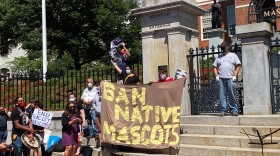I still remember Friday night football games when we, the Masconomet Regional High School Chieftains, ran onto the field as the band and spectators cheered along to the “tomahawk chop.”
Thirty-seven Massachusetts high schools use Native American imagery for their team names and mascots.
State Senator Barbara L’Italien sponsored a bill in 2017 prohibiting such usage.
Masconomet’s superintendent Kevin Lyons opposed the bill, saying, "For most of us here, it doesn't have the same connotation as Redskins or some of the other names… It has to do with the sachem that organized in a very peaceful way the Native Americans in this area."
The bill died in committee, but local tribes and activists still support the ban.
My alma mater should, too, because the history of its namesake is not, in fact, a peaceful one.
When it first came into being, my regional school district sought a common identity behind which the towns of Topsfield, Boxford and Middleton could rally. It found this in Sagamore Masconomet, chief of Agawam — what is known today as Essex County.
The folklore around Masconomet is based on works by local historians partial to English values. In 1630, Masconomet greeted John Winthrop at Salem, and later sold his land to Winthrop’s son at bargain prices. But really, the story is more desperate than friendly.
European colonists brought new disease to North America, and by the time of Masconomet’s meeting with Winthrop at Salem, smallpox had decimated the local Native population.
Masconomet’s own tribe was weakened to fewer than 100. Increasingly vulnerable, it was subject to deadly raids by rival tribes. Masconomet’s people were squeezed, exploited and debilitated by attrition.
Winthrop soon recognized the agricultural fertility of Agawam, as did a new French colony in Nova Scotia. To keep it from falling into French hands, and to secure more acreage for farmers pushed out of Boston by overcrowding, Winthrop sent his son to negotiate for Masconomet’s land. Unable to defend his territory or people, Masconomet had no choice but to sell.
My alma mater uses the name Masconomet to perpetuate a false narrative. Now is the opportune moment for it to reduce — by at least one — the list of Massachusetts high schools that misuse Native American imagery.
Now that’s something we could rally behind.
Nick DeLuca is working toward his master's degree in public history at UMass Amherst. An earlier version of this commentary appeared in The Salem News.






